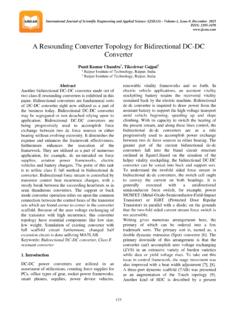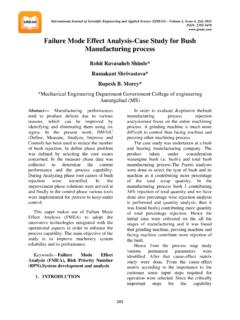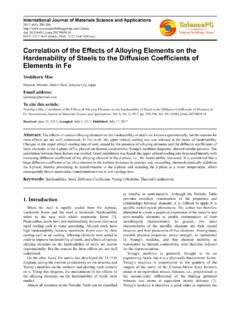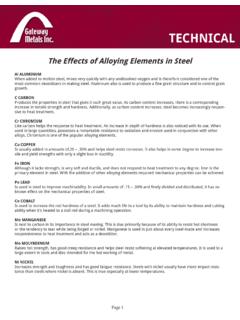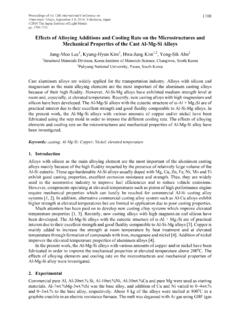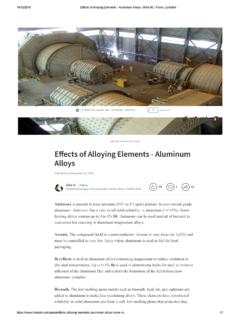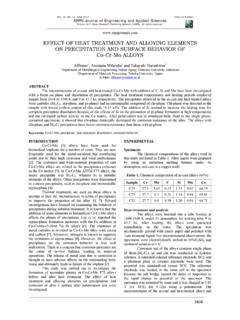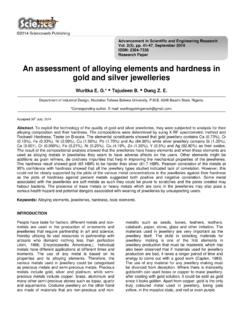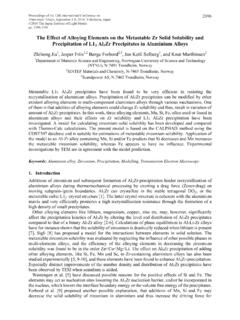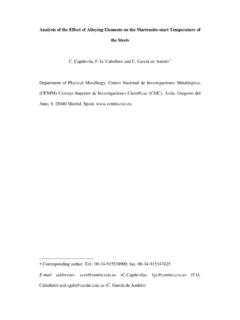Transcription of EFFECT ON MECHANICAL PROPERTIES DUE TO ALLOYING …
1 International Journal of Scientific Engineering and Applied Science (IJSEAS) - Volume-1, Issue-5, August 2015 ISSN: 2395-3470 EFFECT ON MECHANICAL PROPERTIES DUE TO ALLOYING elements Sanjeev Kumar1 Assistant Professor, Deptt. of MECHANICAL Engg. SVSU. Meerut UP Gajbhiye Avinash Deorao2 Research Scholar, Subharti University, Meerut. UP Abstract The present study pertains to changes in MECHANICAL PROPERTIES of Plain carbon & Alloy steel. An experimental study has been made on Plain carbon and Alloy steel.
2 Two main studies have been carried out. In the first study, Plain carbon steel was prepared in Electric Arc Furnace and subjected to all the heat treatment operation like Annealing, Hardening, Tempering and Stress- relieving. Later on the hardness was also listed for the specimen prepared which was found to be 203 BHN in cast 1 & 207 BHN in The MECHANICAL PROPERTIES were also listed and found yield strength TSI, UTS, 24% Elongation and Impact 70, 71, 72 Ft .Lb. And 5 different readings have been taken on different cast from 1 to 5 to know the exact value.
3 In the second study, ALLOYING elements were added to 5 castings and Heat Treatment process operation were carried out like Normalizing, Hardening, Tempering, and stress-relieving operation for Test piece sample. After that checked the hardness of Cast was found their Cast no 1A 314 BHN and 320 BHN. MECHANICAL PROPERTIES were also checked and the cast no 1A - , kgf/mm sq UTS, 22%E, and Impact property , , mm Kgf in alloy steel. And same procedure was carried out for five heat cast heat samples.
4 Key Words: - Ultimate Tensile Strength, Yield Strength &Hardness. Introduction Steel is an alloy of iron and one or more of other elements like carbon, chromium, silicon, vanadium, tungsten, molybdenum and so on with definite percentage of carbon ranges from [1], plain carbon steels are those containing [2]. There are two main reasons for the popular use of steel: (1) It is abundant in the earth s crust in form of Fe2O3 and little energy is required to convert it to Fe.
5 (2) It can be made to exhibit great variety of microstructures and thus a wide range of MECHANICAL PROPERTIES . If one or more elements , other than carbon, are added to steel to ensure specific PROPERTIES , such as better MECHANICAL strength ductility, electrical PROPERTIES , magnetic PROPERTIES and so on. Alloy steels are also broadly divided into three different types. Low-alloy steels: total ALLOYING content is less than about 5%. Medium-alloy steels: total ALLOYING content is in the range of 5-10%.
6 High-alloy steels: total ALLOYING content is above 10%. The main constituents of plain carbon steel are iron and carbon. The PROPERTIES of carbon steels are directly related to the percentage of carbon present. In addition to carbon, plain carbon steels also contain other elements such as, manganese, silicon, sulphur and phosphorus in the amounts shown above Table Composition Range Of Carbon Steels Sr. No. elements Percent By Weight 1 Carbon to 2 Manganese to 3 Silicon 0 to 4 Sulphur MAX.
7 5 Phosphorus MAX. 6 Iron BALANCE Steel can be hardened to resist cutting action and prevent abrasion .the rate of cooling and the manner of cooling are the controlling factor in heat treatment process .heat treatment not only increases 46 International Journal of Scientific Engineering and Applied Science (IJSEAS) - Volume-1, Issue-5, August 2015 ISSN: 2395-3470 the hardness but also increases the tensile strength and toughness. Hardness is an important MECHANICAL property of the machinery components.
8 Higher hardness material has higher wear and abrasion resistance .hardening process increases the hardness but it affects the other MECHANICAL PROPERTIES , like fatigue strength (or fatigue life), impact strength, ultimate tensile strength (UTS) etc.[3] .In hardening, the steel or its alloy is heated to a temperature high enough to promote the formation of austenite, held at that temperature until the desired amount of carbon has been dissolved and then quench in oil or water at a suitable rate [4]. There are various heat treatment processes Heat Treatment process operation which we have adopted for testing like Normalizing, Hardening and stress-relieving operation.
9 There are many tests to measure MECHANICAL PROPERTIES , but we shall discuss some of the important and common tests, such as hardness test, tensile test and impact test. EFFECT of ALLOYING elements ALLOYING elements affect the constitution, characteristics, and behavior of carbon steels in many ways. Some of the major effects of ALLOYING elements are, strengthening of ferrite, formation of special carbides and compounds, shifting of critical temperatures and compositions, and lowering of critical cooling rate.
10 2. Experimental Procedure: In the study of MECHANICAL PROPERTIES and their testing there are certain things which are considered basic or fundamental. A test almost universally employed to express MECHANICAL PROPERTIES and supply the most useful fundamental information regarding behaviour of materials is the tensile test. In practically tensile testing machine consists essentially of two parts: (1) the unit for applying a load to the specimen, and (2) the measuring device for the measurement of the load on the specimen.
